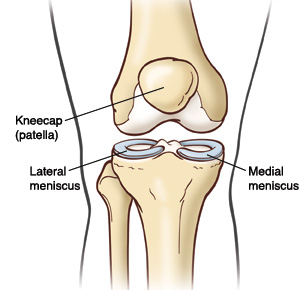Knee Pain with Possible Torn Meniscus

The meniscus is a tough cartilage pad that cushions the inside of the knee joint. It helps absorb the shock from movement. It also spreads the weight of your body evenly across the knee joint. This prevents excess wear and tear to the bones of that joint.
The most common causes of meniscal tears are injuries, especially related to sports and degenerative disease that happens with aging.
A meniscus tear often happens during a twisting injury when the knee is bent. This causes pain, swelling, reduced movement of the knee, and trouble walking. There may be popping, clicking, joint locking, or not being able to fully straighten the knee. Ligaments of the knee may also be injured.
A torn meniscus is diagnosed by physical exam and X-rays. In the case of a severe injury, the knee may be too painful to examine fully. A more accurate exam can be done after the initial swelling goes down. An MRI may be done to make a final diagnosis.
If your healthcare provider suspects a meniscal injury, your knee may be treated with ice and rest. You may also need to limit movement of the knee. A splint or knee brace that keeps your leg straight may be put on to protect the joint. Depending on the severity of the injury, surgery may be needed. A cartilage injury may take 4 to 12 weeks to heal depending on how bad it is.
Home care
-
Stay off the injured leg as much as possible until you can walk on it without pain. If you have a lot of pain when walking, crutches or a walker may be prescribed. (These can be rented or bought at many pharmacies and surgical or orthopedic supply stores). Follow your healthcare provider's advice about when to begin putting weight on that leg.
-
Keep your leg elevated to reduce pain and swelling. When sleeping, place a pillow under the injured leg. When sitting, support the injured leg so it's above heart level. This is very important during the first 48 hours.
-
Put an ice pack over the injured area for 15 to 20 minutes every 3 to 6 hours. You should do this for the first 24 to 48 hours. To make an ice pack, put ice cubes in a plastic bag that seals at the top. Wrap the bag with a thin towel before using it. Keep using ice packs to ease pain and swelling as needed. As the ice melts, be careful not to get your wrap, splint, or cast wet. After 48 hours, put heat (warm shower or warm bath) for 15 to 20 minutes several times a day, or alternate ice and heat. You can place the ice pack directly over the splint. If you have to wear a hook-and-loop knee brace, you can open it to apply the ice pack, or heat, directly to the knee. Never put ice directly on the skin. Always wrap the ice in a towel or other type of cloth.
-
You may use over-the-counter pain medicine to control pain, unless another pain medicine was prescribed. A nonsteroidal anti-inflammatory drug (NSAID) like ibuprofen or naproxen would work better than acetaminophen. Talk with your provider before using these medicines if you have chronic liver or kidney disease, ever had a stomach ulcer or gastrointestinal bleeding, or take a blood thinner.
-
If you were given a splint, keep it dry at all times. Bathe with your splint out of the water. Protect it with a large plastic bag that is rubber-banded or taped at the top end. If a fiberglass splint gets wet, you can dry it with a hair dryer set on cool. If you have a hook-and-loop knee brace, you can remove this to bathe, unless told otherwise.
-
Check with your provider before returning to sports or full work duties.
Follow-up care
Follow up with your healthcare provider as advised. This is often within 1 to 2 weeks. You may need more testing to check the extent of your injury.
If X-rays were taken, you'll be told of any new findings that may affect your care.
Call 911
Call 911 if you have:
-
Shortness of breath
-
Chest pain
When to get medical advice
Call your healthcare provider right away if any of these occur:
-
Toes or foot gets swollen, cold, blue, numb, or tingly
-
Pain or swelling spreads over the knee or calf
-
Warmth or redness appears over the knee or calf
-
Fever of 100.4°F (38°C) or higher, or as directed by your provider
-
Chills